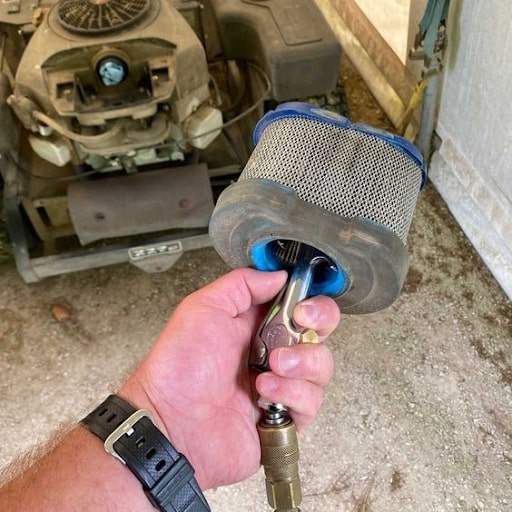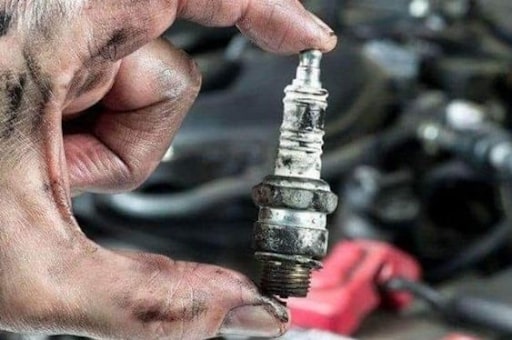What can be more annoying than pulling the cord on your lawn mower and hearing it turn over, only to realize that it’s not starting? This kind of problem is quite common with a lawn mower, and it’ll definitely lead you to the question: “Why is my lawn mower turning over but not starting?”
Common reasons for your lawn mower turning over but not starting can include low oil levels, dirty air filter, faulty spark plug, stale fuel, clogged carburetor, dead battery, broken gears and clutch, or faulty ignition coil. Problems with the air, fuel, and spark supply systems are usually to blame.
But the good news is that with little troubleshooting, you can fix the problem and get your lawn mower running again. In this article, we’ll take a deeper look into these problems and provide you with solutions to diagnose and solve the issue. So keep reading for more information.
Table Of Contents
Key Takeaways
- The lawn mower turning over but not starting is a common problem.
- There are numerous causes leading to the issue, such as low oil levels, dirty air filters, faulty spark plug, dead battery, clogged carburetor, stale fuel, etc.
- You can solve most of these issues, related to starting a lawn mower, without professional help.
- Maintaining the lawn mower and keeping it in proper shape is the best way to prevent any problems.
Top Common Reasons For Lawn Mower Not Starting And Their Possible Solutions
Mentioned below are some of the most common reasons for your lawn mower not starting and some effective solutions to the problem.
Dead Battery
A dead battery is one of the immediate causes preventing an electric lawn mower from starting. A battery is responsible for different jobs like operating the starter motor, engaging the fuel solenoid, starter solenoid, and the electric clutch. Moreover, the battery supplies electric current to turn over the engine.
So when the battery is dead, it won’t be able to provide enough power and do its job to start the lawn mower. In most cases, a weak battery may be able to turn over the engine but lacks enough power to start it.
One of the common signs of a dead lawn mower battery is low voltage load. Use a multimeter to test the battery voltage. If the voltage shows below 12, it’s a sign of a dead battery. Other signs of a dead lawn mower battery are slow cranking, clicking sounds, dim lights, etc.
The Solution:
If you notice these signs and confirm that it’s a battery issue, you should first try charging the battery. The best thing to do is to remove the battery from the lawn mower and charge it separately. Disconnecting the battery helps you figure out if there is any electrical fault in the lawn mower.
Charge the battery fully, which takes around 8 to 10 hours. If the battery still indicates low charging status, maybe it’s time to replace it.
When the battery is charged, test the voltage again. Reinstall the battery and run the lawn mower. If you don’t face any further issues, then the flat battery was the problem. Now, your lawn mower is good to resume work.
Related: Electric vs Gas Lawn Mower – Which One Is Suitable For you?
Dirty Air Filter

Dirty air filters are another reason that prevents the lawn mower from starting. An air filter covered with dirt, grass, sand, dust, or anything similar isn’t a healthy sign. When the air filter is covered with a very thick layer of dirt, it prevents the engine from getting enough air, which is necessary to start the combustion process in the engine.
The Solution
When you see your lawn mower filter covered with dirt and dust, you should immediately clean it. The cleaning procedure of the air filter may vary from model to model. But before starting the cleaning process, you must disconnect the spark plug wire for safety reasons.
The air filter is usually found near the top of the engine, and it has a cover. You need to remove the cover first and then remove the air filter. If your lawnmower has a paper filter, gently tap on the flat surface to get rid of the dirt. Hold up the filter to a bright light source. If the filter blocks the light significantly, you must replace the paper element. Most people try to clean this dirty paper, but this is actually of no use. The best thing to do is get a new one.
For mowers with a foam filter, if the filter has a yellow or brownish stain and shows signs of crumbling, you should change the filter. If there are no such stains, you can clean and reuse the filter.
Related: Why Is My Lawn Mower Smoking? 9 Reasons & Solutions
Fuel Issues
Common fuel problems like stale or contaminated fuel also prevent the lawn mower from starting. Stale fuel is the oil that’s been sitting in the tank for too long and has started to break down. Over time the volatile compounds in the stale oil start evaporating, leaving behind a gummy residue that can clog the fuel system. If your lawn mower has not been used for a long time and it’s not starting, it could be due to stale fuel.
Contaminated fuel, which means fuel mixed with other substances like dirt or water, is another reason for the engine not starting. Contaminants can also clog the fuel system and prevent the engine from getting the fuel it needs to start the engine.
The Solution
The solution for stale fuel is to drain the oil and replace it before using the lawn mower if it’s not been used for a long time. And to prevent the issue of contaminated fuel, use a fuel stabilizer to keep the fuel fresh as it prevents the fuel from absorbing moisture from the air. Also, clean and maintain the fuel system regularly to prevent these problems.
Spark Plug Issues

The lawn mower spark plug creates the spark that ignites the fuel in the engine. A faulty spark plug that is either disconnected, loosened, or coated with carbon residue or water will prevent the mower from starting. If you’re certain that the problem of your lawn mower not starting lies with the spark plug, you should take immediate action to cure the issue.
The Solution
First, locate the spark plug and disconnect it to prevent accidental starting. The spark plug is usually found at the front of the mower, a small metal component with a threaded base. Remove it using a socket wrench and check the condition of the electrode, the ceramic coating, and the terminal that connects the wire.
If the electrode is dirty, use a spray brake cleaner and let it sit on the spark plug for a few minutes. Then wipe it off with a clean cloth and reinstall the spark plug. But if the electrode is crooked, burnt, or damaged in any other way, you should replace it with a new one, and it should solve the problem.
Clogged Carburetor
If the lawn mower carburetor is dirty or clogged, your lawn mower may turn over but not start or not start at all. The carburetor is responsible for mixing air and fuel in the correct ratio to create combustion in the engine. The carburetor is a critical component of the lawn mower, and its health can impact the entire engine’s performance.
Therefore, it’s essential to maintain the carburetor to prevent such issues. But if you already have a clogged carburetor, you must adopt appropriate measures.
The Solution
Usually, the carburetor gets clogged, due to issues with the air filter in it. So the first thing you should do is check the air filter. If it’s dirty, the carburetor won’t be able to draw in any air. The issue occurs because leftover air gets condensed and solidified in the air filter, preventing it from pulling air.
Remove the carburetor and clean it thoroughly, using a small brush and a carburetor cleaner spray. This should get rid of dirt, debris, and other clogs. Also, check for any damaged parts, like the workout gasket, and replace them if required. Once done, reinstall it and try starting the engine.
Removing, disassembling, and cleaning the carburetor may not be everyone’s cup of tea. If you’re not comfortable doing it, get it done by a professional.
Related: Best Zero Turn Mower In 2023 – 5 Models To Consider
Low Oil Levels
Last but not least, low oil levels are a common and obvious reason for the lawn mower not starting. Reasons for low oil levels could include the following: you haven’t refilled the tank for a long time; your previous mowing session was quite long, which consumed a lot of fuel; the lawn mower has old fuel, etc. Old gasoline loses its potency and is unable to combust, preventing the mower from starting.
The Solution
Check the oil level with the dipstick. If the oil level is low, add oil and refill the tank. This would solve your issue. If there is old fuel, drain and clean the tank, and then add new oil.
Related: What Is A Brushless Lawn Mower – Everything You Should Know
Why Is My Lawn Mower Not Starting FAQs
- What Is The First Thing to Check if A Lawn Mower Won’t Start?
The first thing to check when the lawn mower won’t start is the air filter and the fuel level. Low oil levels and a dirty filter are the most common causes of the problem, so inspect them first and take necessary actions.
- How Do You Force Start A Lawn Mower?
Force starting the lawn mower isn’t recommended, as it can be dangerous and cause further damage to the engine. Address the underlying issue first and fix it accordingly.
- Why Does My Riding Lawn Mower Stop Running While Mowing?
A riding lawn mower may stop while mowing, due to the engine being overheated, low fuel, or any other mechanical issue.
- Why Won’t My Lawn Mower Turn With A New Battery?
Some possible causes of the lawn mower not starting even with a new battery are starter solenoid issues, poor battery connection, ignition switch issues, fuse problems, etc.
Related: Best Self-Propelled Lawn Mower – 5 Models For All Budgets And Terrains
Conclusion
Seeing your lawn mower not starting is quite annoying. But instead of getting irritated, you should try to understand the issue and take appropriate steps at the earliest. Hopefully, this article has helped you learn various causes of the issue along with the problems’ solutions.
Most of these issues have easy fixes, which you can do on your own. Still, it’s best to seek help from a professional when you’re unsure about any step of the repair process. Routine inspection and cleaning are the best ways to keep this garden equipment swift and running smoothly for years.


